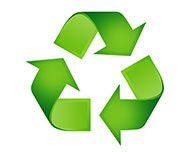Glass Glossary
Our Recycling Program

Did you know that The Green Window Company donates old windows and doors to local charities for re-use?
Connect With Us
A Class in glass

Discussions about windows can look like they were pulled straight from a bowl of alphabet soup. Ratings are described in terms of ABCs. The labels refer to R values, U values, and UV coatings.
But what do these ratings actually mean?
ABC Rating – Every new window is identified with “ABC” ratings up to a maximum of A3B7C5. These measure how well the window will stand to air (A), water (B) and wind loads (C). The minimum rating for a Toronto-area home is A2B2C3.
A (wind) – The air-related ratings are measured by applying a 40 km-h wind across the window. An A1 reading shows the window will leak a little. An A3 reading is air-tight.
B (water) -- The water-related rating shows how well the window will stand up to a driving rain, protecting the home from damaging water and mold. A window with a B7 rating can withstand a driving rain and 120 km-h wind.
C (wind loads) – The wind load rating demonstrates how will the window will stand up to a strong wind. A window with a C1 rating will begin to flex in the face of a gale force wind that is blowing at between 62 and 74 km-h. Most customers need at least a C2. But high-rise buildings might require windows with a C5 rating.
R Value – R values are often used to describe the quality of insulations inside your home’s walls. They also describe the energy efficiency of the window. A single piece of glass will typically have an R1 insulating value. Add an insulating spacer between two pieces of the glass and the rating climbs to R2. Combine low-E glass with a layer of argon gas and the rating climbs to R4. A triple-pane window can deliver a rating as high as R9 – almost half as much as a fully insulated wall!
HVAC – A home’s Heating, Ventilation and Air Conditioning (HVAC) system includes everything from the furnace to the air conditioner and the ducts which deliver the air. High-quality windows and doors will reduce the strain on this equipment, and help to lower energy bills in the process.
Low-E – A low-Emissivity (low-E) coating can improve the insulating value of a window by up to 40%, reduce condensation, and even help to protect a room’s furniture from the fading power of the sun. The coating will also retain the radiated heat created by your furnace, while reflecting some of the unwanted rays from a hot summer sun.
PVC – Polyvinyl Chloride (PVC) has been used to make millions of window frames, and creates a long-lasting product that requires very little maintenance.
SHGC – The Solar Heat Gain Coefficient (SHGC) measures the solar heat that can pass through a window, and even considers different angles or shade from the window frame. This rating is particularly important for those with large, south-facing glass windows. New Energy Star standards require a minimum SHGC of 0.22. The right coating on the glass will give a window a low SHGC to block heat-producing light waves, but still allow a lot of visible light (VT).
U-value – The U value measures the amount of heat that can transfer through the window. A window with a low U value will save more energy because it will have features like extra glazing, better spacers, or an insulating gas like argon.
ER – The ER rating measures the overall performance of a window, including solar heat gains; the heat lost through frames, spacers and glass; and heat lost because of air leaks.


